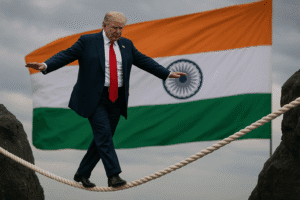The Trump Tariff Tightrope: How India Balances Energy Needs and Strategic Autonomy
India’s Strategic Dilemma Under Trump’s Tariff Pressure
Donald Trump’s unprecedented move to link U.S. tariffs on Indian goods to New Delhi’s Russian oil imports transforms trade policy into an energy weapon. India now faces an agonizing choice: preserve access to discounted crude—vital for taming inflation and its $15 billion current account deficit—or safeguard its hard-won strategic autonomy.
For years, India balanced ties with Russia and the West, but Trump’s penalties threaten this multi-alignment by targeting its BRICS affiliations and de-dollarization efforts. Compounding the pressure, Washington’s diplomatic pivot toward Pakistan signals shifting alliances. If enforced, sanctions could force India into costlier energy alternatives, risking economic stability. New Delhi’s response—whether recalibrating suppliers, resisting coercion, or accelerating green energy—will redefine its role in a fractured global order where sovereignty carries a steep price.

The Trump Tariff Tightrope: How India Balances Energy Needs and Strategic Autonomy
A New Front in the Trade Wars: Energy as a Weapon
Donald Trump’s latest tariff salvo against India isn’t just about trade—it’s a calculated move to turn energy into a geopolitical lever. By threatening higher duties on Indian imports unless New Delhi curbs its Russian oil purchases, Trump has forced India into an unenviable dilemma: prioritize affordable energy or safeguard its strategic independence.
This escalation marks a shift from traditional trade disputes to a more aggressive form of economic statecraft, where access to cheap crude is no longer just a market decision but a litmus test of geopolitical alignment. For India, which imports over 85% of its oil, the stakes couldn’t be higher.
India’s Russian Oil Gamble: Pragmatism vs. Pressure
Since Russia’s invasion of Ukraine, India has capitalized on discounted Russian crude, at one point sourcing nearly 40% of its oil imports from Moscow. This move, framed as pragmatic non-alignment, helped stabilize fuel prices, boost refining margins, and keep the current account deficit in check.
But Trump’s latest threat—tying trade penalties to India’s energy deals—could disrupt this carefully balanced equation. If secondary sanctions or financial restrictions follow, Indian refiners may be forced to pivot to costlier alternatives, with ripple effects across the economy.
The Cost of Compliance:
- A $10 rise in crude prices could widen India’s current account deficit by $15 billion (0.4% of GDP).
- Higher fuel costs would stoke inflation and weaken the rupee, squeezing households and businesses alike.
- Replacing Russian oil with pricier US or Middle Eastern supplies would strain an already import-dependent energy strategy.
Strategic Autonomy Under Fire
India has long prided itself on multi-alignment—buying Russian arms while deepening US defense ties, engaging with BRICS while courting Western investment. But Trump’s tariff ultimatum exposes the fragility of this approach in an increasingly polarized world.
The BRICS Backlash:
Trump’s explicit criticism of India’s BRICS ties reveals Washington’s growing unease with the bloc’s de-dollarization efforts. While India has cautiously explored rupee-rouble trade mechanisms, its participation in BRICS is now under scrutiny, with the US framing it as a challenge to dollar dominance.
Pakistan’s Resurgence:
Adding to India’s geopolitical headaches is Washington’s rekindled engagement with Pakistan. Reports of revived military and infrastructure deals suggest Trump’s transactional diplomacy may be reshaping regional alliances, leaving India in a precarious spot.
India’s Possible Paths Forward
Faced with mounting pressure, India has three broad options:
- Recalibration: Shift back to Gulf suppliers, secure long-term US LNG contracts, and build strategic reserves to buffer against volatility.
- Resistance: Double down on Russian oil despite penalties, leveraging deeper discounts or alternative payment systems to mitigate fallout.
- Acceleration: Fast-track renewable energy adoption to reduce dependence on hydrocarbon geopolitics altogether.
Industry sources suggest that, for now, Indian refiners remain committed to Russian crude, prioritizing cost-efficiency over political risk. But if banking or shipping sanctions tighten, New Delhi may be forced into tough concessions.
The Bigger Picture: A New Era of Energy Blackmail?
Trump’s move signals a dangerous precedent—where trade policy is weaponized to dictate energy choices. If successful, other nations could face similar coercion, reshaping global oil flows and alliances.
For India, the challenge is clear: navigate this high-stakes squeeze without surrendering its strategic autonomy or economic stability. The world is watching to see if New Delhi can walk this tightrope—or if it will be pushed into choosing sides in an increasingly fractured global order.
Final Thought:
In the past, energy security was about securing the cheapest barrel. Today, it’s about surviving the geopolitical crossfire that comes with it. India’s next moves will reveal whether non-alignment is still viable—or if the era of forced choices has arrived.
You must be logged in to post a comment.